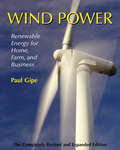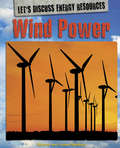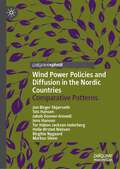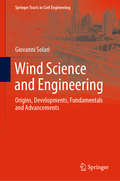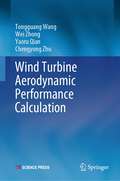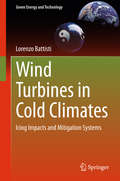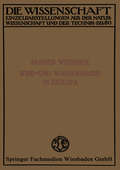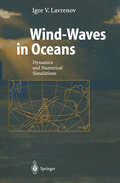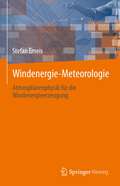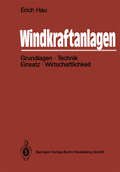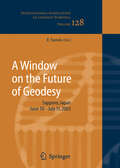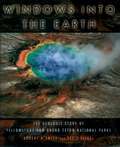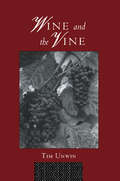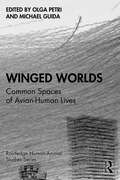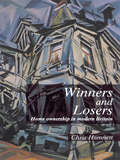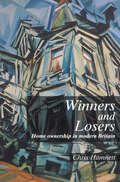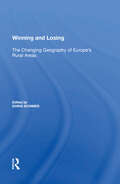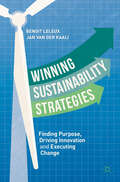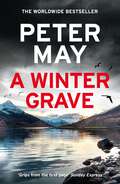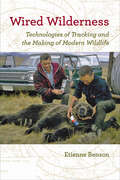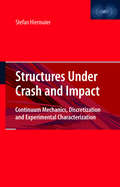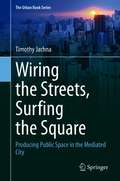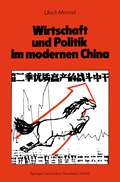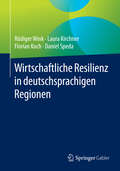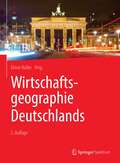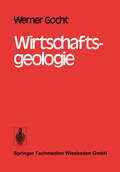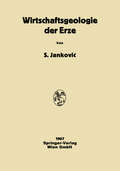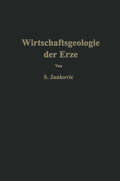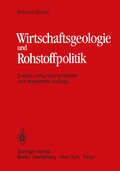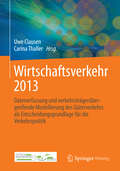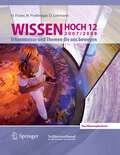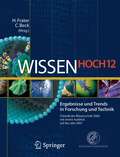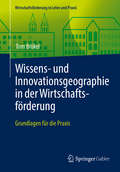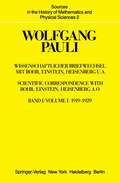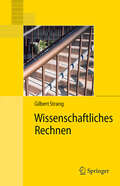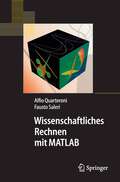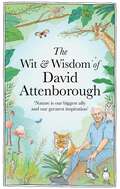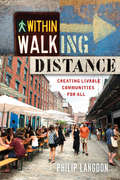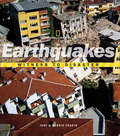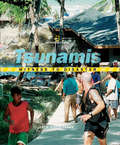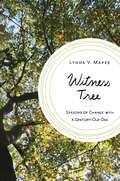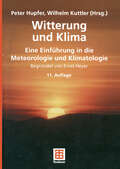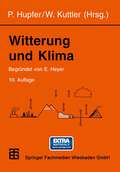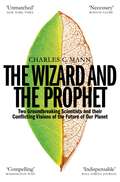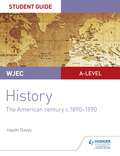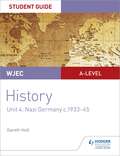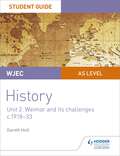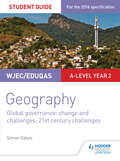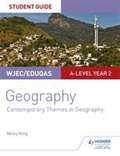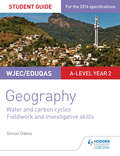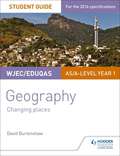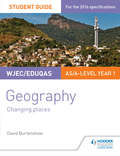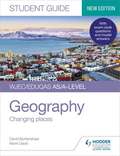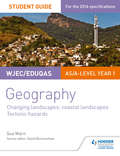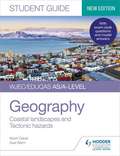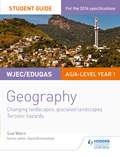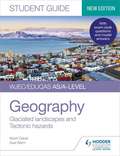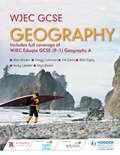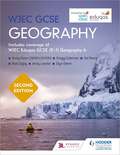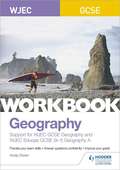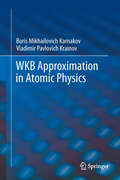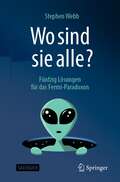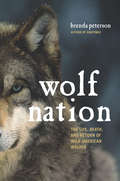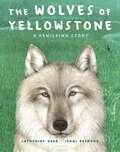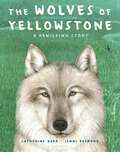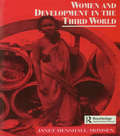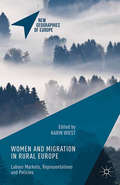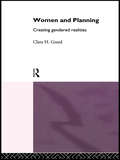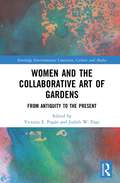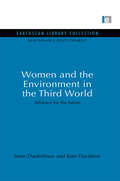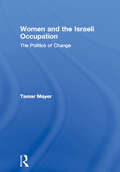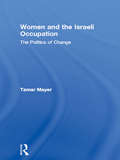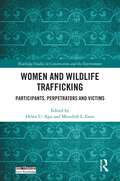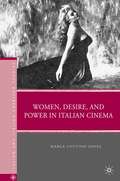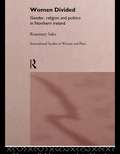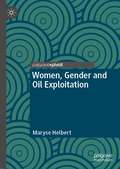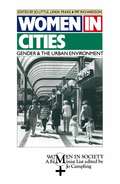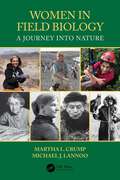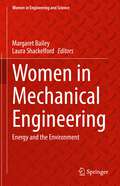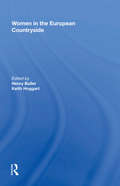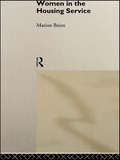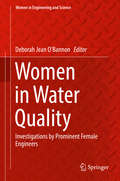- Table View
- List View
Wind Power: Renewable Energy for Home, Farm, and Business, 2nd Edition
by Paul GipeIn the wake of mass blackouts and energy crises, wind power remains a largely untapped resource of renewable energy. It is a booming worldwide industry whose technology, under the collective wing of aficionados like author Paul Gipe, is coming of age. Wind Power guides us through the emergent, sometimes daunting discourse on wind technology, giving frank explanations of how to use wind technology wisely and sound advice on how to avoid common mistakes. Since the mid-1970s, Paul Gipe has played a part in nearly every aspect of wind energy’s development—from installing small turbines to promoting wind energy worldwide. As an American proponent of renewable energy, Gipe has earned the acclaim and respect of European energy specialists for years, but his arguments have often fallen on deaf ears at home. Today, the topic of wind power is cropping up everywhere from the beaches of Cape Cod to the Oregon-Washington border, and one wind turbine is capable of producing enough electricity per year to run 200 average American households. Now, Paul Gipe is back to shed light on this increasingly important energy source with a revised edition of Wind Power. Over the course of his career, Paul Gipe has been a proponent, participant, observer, and critic of the wind industry. His experience with wind has given rise to two previous books on the subject, Wind Energy Basics and Wind Power for Home and Business, which have sold over 50,000 copies. Wind Power for Home and Business has become a staple for both homeowners and professionals interested in the subject, and now, with energy prices soaring, interest in wind power is hitting an all-time high. With chapters on output and economics, Wind Power discloses how much you can expect from each method of wind technology, both in terms of energy and financial savings. The book’s updated models, graphics, and weighty appendixes make it an invaluable reference for everyone interested in the emerging trend of wind power and renewable energy. Executive Director of the American Wind Energy Association Randall Swisher has said, "In the last two decades, no one has done more that Paul Gipe to bring wind energy to the public’s attention."
Wind Power: Wind Power Library Ebook (Let's Discuss Energy Resources #1)
by Richard Spilsbury Louise SpilsburyWith supplies of non-renewable energy sources running low and the threat of global warming and climate change, there is an urgent need to look at other types of energy resources and how well they can meet our power needs. While new technologies are being developed, each energy resource comes at a cost. This series looks at each energy resource, the technology and cost of how it is used to meet power needs and how it impacts the environment and humans. Each book explains how that power is generated and where it is used, and then, using specific Let's Discuss panels, explores the various advantages and disadvantages that concern it's use as an alternative fuel source. Case studies examine specific usage examples where that source has either worked or not worked so that the reader can weigh up the pros and cons for the use of each source against the alternatives.
Wind Power Policies and Diffusion in the Nordic Countries: Comparative Patterns
by Jon Birger Skjærseth Teis Hansen Jakob Donner-Amnell Jens Hanson Helle Ørsted Nielsen Birgitte Nygaard Markus Steen Tor Håkon InderbergThis book focuses specifically on policy mixes and wind power diffusion in four Nordic countries – Denmark, Finland, Norway and Sweden. Although these Nordic welfare states have much in common, they have adopted different wind power policies and experienced dissimilar diffusion trajectories. Understanding these patterns across the Nordic countries is the central puzzle that this book investigates. Empirically, this book provides a first-of-its-kind comparative study of wind power policies in the Nordic countries. Analytically, the authors contribute to the transition policy mix literature, which remains largely insensitive to political feasibility. This book will be of interest to researchers and students as well as private and public decision makers looking for tools to enable the energy transition.
Wind Science and Engineering: Origins, Developments, Fundamentals and Advancements (Springer Tracts in Civil Engineering)
by Giovanni SolariThis book provides an essential overview of wind science and engineering, taking readers on a journey through the origins, developments, fundamentals, recent advancements and latest trends in this broad field. Along the way, it addresses a diverse range of topics, including: atmospheric physics; meteorology; micrometeorology; climatology; the aerodynamics of buildings, aircraft, sailing boats, road vehicles and trains; wind energy; atmospheric pollution; soil erosion; snow drift, windbreaks and crops; bioclimatic city-planning and architecture; wind actions and effects on structures; and wind hazards, vulnerability and risk. In order to provide a comprehensive overview of wind and its manifold effects, the book combines scientific, descriptive and narrative chapters. The book is chiefly intended for students and lecturers, for those who want to learn about the genesis and evolution of this topic, and for the multitude of scholars whose work involves the wind.
Wind Speed and Direction Symbol (tactile)
by Sheffield Vi ServiceThis is an image of the meteorological symbol for wind speed and direction. The wind speed is shown in the circle at the centre of the page.
Wind Turbine Aerodynamic Performance Calculation
by Tongguang Wang Wei Zhong Yaoru Qian Chengyong ZhuThis book deals with horizontal-axis wind turbine aerodynamic performance prediction methods. It focuses on the traditional and newly-developed methods for the wind turbine aerodynamic performance calculation. The fundamental theories of fluid mechanics essential for understanding the other parts of this book are firstly introduced in Part I, followed by the blade element momentum theory in Part II, with special attentions to a systematic review of various correction models. Part III is mainly about the prescribed and free vortex wake methods, while the state-of-art computational fluid dynamics (CFD) methods are detailed in Part IV.Part III thoroughly describes the prescribed and free vortex wake methods which are still of great importance towards realistic investigation of wind turbine performance. Despite the highly computational cost, the CFD methods in Part IV have received increasing interest from the academic community since they provide more detailed information about the flow field around the wind turbine. This has shed a light in combination with the correction models introduced in Part II on more advanced research for wind turbine.This book is intended for researchers and students interested in aerodynamics of wind turbine and is particularly suitable for practicing engineers in wind energy. Readers can gain a comprehensive understanding in both classical and up-to-date methods for the study of wind turbine aerodynamics. The authors hope that this book can promote the research and development of wind turbines.
Wind Turbines in Cold Climates: Icing Impacts and Mitigation Systems (Green Energy and Technology)
by Lorenzo BattistiThis book addresses the key concerns regarding the operation of wind turbines in cold climates and focuses in particular on the analysis of icing and methods for its mitigation. Topics covered include the implications of cold climates for wind turbine design and operation, the relevance of icing for wind turbines, the icing process itself, ice prevention systems and thermal anti-icing system design. In each chapter, care is taken to build systematically on the basic knowledge, providing the reader with the level of detail required for a thorough understanding. An important feature is the inclusion of several original analytical and numerical models for ready computation of icing impacts and design assessment. The breadth of the coverage and the in-depth scientific analysis, with calculations and worked examples relating to both fluid dynamics and thermodynamics, ensure that the book will serve not only as a textbook but also as a practical manual for general design tasks.
Wind- und Wasserhosen in Europa (Die Wissenschaft)
by Alfred WegenerDieser Buchtitel ist Teil des Digitalisierungsprojekts Springer Book Archives mit Publikationen, die seit den Anfängen des Verlags von 1842 erschienen sind. Der Verlag stellt mit diesem Archiv Quellen für die historische wie auch die disziplingeschichtliche Forschung zur Verfügung, die jeweils im historischen Kontext betrachtet werden müssen. Dieser Titel erschien in der Zeit vor 1945 und wird daher in seiner zeittypischen politisch-ideologischen Ausrichtung vom Verlag nicht beworben.
Wind-Waves in Oceans: Dynamics and Numerical Simulations (Physics of Earth and Space Environments)
by Igor LavrenovThe study of sea waves has always been in the focus of mankind's atten tion. This is attributed not only to a desire to understand the behaviour in seas and oceans, but also, it has some practical necessity. Developing up-to date wind wave numerical methods requires detailed mathematical modelling, starting with wave generation, development, propagation and transformation on the surface in different water areas under quasi-stationary conditions, up to a synthesis of climatic features observed under different wave generation conditions in oceans, sea or coastal areas. The present monograph considers wind waves in terms of the most general formulation of the problem as a probable hydrodynamic process with wide spatial variability. It ranges between the global scale of the oceans, whose typical size is comparable with the Earth's radius, to the regional and local scales of the seas, including water areas limited in space with significant current or depth gradients in coastal zones, where waves cease their existence having propagated tens of thousand miles.
Wind Weathering (large print)
by RnibThis page shows an image of a rock formation. There is a locator dot shown, which will be at the top left when the image is the correct way up. The image is surrounded by an image border. The ground goes from the left to the right at the bottom of the page. It is in three layers. There is a rock in the centre of the page which sits on the ground and goes up to the top centre of the page. It has lots of layers. The wind has picked particles of sand up and blasted them against this rock eroding it and creating this strange shape. The softer layers of rock have been eroded more than the harder layers.
Wind Weathering (UEB contracted)
by RnibThis page shows an image of a rock formation. There is a locator dot shown, which will be at the top left when the image is the correct way up. The image is surrounded by an image border. The ground goes from the left to the right at the bottom of the page. It is in three layers. There is a rock in the centre of the page which sits on the ground and goes up to the top centre of the page. It has lots of layers. The wind has picked particles of sand up and blasted them against this rock eroding it and creating this strange shape. The softer layers of rock have been eroded more than the harder layers.
Wind Weathering (UEB uncontracted)
by RnibThis page shows an image of a rock formation. There is a locator dot shown, which will be at the top left when the image is the correct way up. The image is surrounded by an image border. The ground goes from the left to the right at the bottom of the page. It is in three layers. There is a rock in the centre of the page which sits on the ground and goes up to the top centre of the page. It has lots of layers. The wind has picked particles of sand up and blasted them against this rock eroding it and creating this strange shape. The softer layers of rock have been eroded more than the harder layers.
Windenergie Meteorologie: Atmosphärenphysik für die Windenergieerzeugung
by Stefan EmeisDieses Buch bietet eine Einführung in die meteorologischen Randbedingungen für die Stromerzeugung aus Wind - sowohl an Land als auch auf See - und liefert meteorologische Informationen für die Planung und den Betrieb dieser wichtigen erneuerbaren Energiequelle. Es umfasst die Herleitung von Windgesetzen und Beschreibungen von Windprofilen, insbesondere oberhalb der logarithmischen bodennahen Schicht, und behandelt Winde über komplexem Gelände und nächtliche Low-Level-Jets. Diese aktualisierte und erweiterte zweite Auflage enthält neue Kapitel, die sich mit der Effizienz großer Windparks und deren Nachläufen sowie mit der Offshore-Windenergie befassen.
Windkraftanlagen: Grundlagen, Technik, Einsatz, Wirtschaftlichkeit
by Erich HauIn diesem Handbuch wird die Technologie moderner Windkraftanlagen systematisch und umfassend dargestellt. Ausgehend von den historischen Wurzeln der Windkraftnutzung führt der Autor über die technisch-physikalischen Grundlagen, den konstruktiven Aufbau, die Einsatzkonzeptionen und die Umweltverträglichkeit bis hin zu Wirtschaftlichkeitsuntersuchungen der Stromerzeugung mit Windenergie. Erstmalig wird eine fundierte Analyse der Herstellkosten moderner Windkraftanlagen gegeben und - darauf aufbauend - die Hauptfrage untersucht, unter welchen Bedingungen man mit dieser besonders umweltfreundlichen Energie wirtschaftlich Strom erzeugen kann. Hierbei werden Investitions- und Betriebskosten genau so berücksichtigt wie die Amortisation dieser modernen Technologie und deren Bedeutung im gesamtwirtschaftlichen Rahmen einer hochentwickelten Industriegesellschaft.
A Window on the Future of Geodesy: Proceedings of the International Association of Geodesy. IAG General Assembly, Sapporo, Japan June 30 - July 11, 2003 (International Association of Geodesy Symposia #128)
by Fernando SansòThese proceedings represent the worldwide picture of the state of the art of geodesy. The volume comprehensively covers the most recent results and supplies a good review of the new ideas developing in the field, opening a window to the future of geodesy.
Windows into the Earth: The Geologic Story of Yellowstone and Grand Teton National Parks
by Robert B. Smith Lee J. SiegelMillions of years ago, the North American continent was dragged over the world's largest continental hotspot, a huge column of hot and molten rock rising from the Earth's interior that traced a 50-mile wide, 500-mile-long path northeastward across Idaho. Generating cataclysmic volcanic eruptions and large earthquakes, the hotspot helped lift the Yellowstone Plateau to more than 7,000 feet and pushed the northern Rockies to new heights, forming unusually large glaciers to carve the landscape. It also created the jewel of the U.S. national park system: Yellowstone. Meanwhile, forces stretching apart the western U.S. created the mountainous glory of Grand Teton National Park. These two parks, with their majestic mountains, dazzling geysers, and picturesque hot springs, are windows into the Earth's interior, revealing the violent power of the dynamic processes within. Smith and Siegel offer expert guidance through this awe-inspiring terrain, bringing to life the grandeur of these geologic phenomena as they reveal the forces that have shaped--and continue to shape--the greater Yellowstone-Teton region. Over seventy illustrations--including fifty-two in full color--illuminate the breathtaking beauty of the landscape, while two final chapters provide driving tours of the parks to help visitors enjoy and understand the regions wonders. Fascinating and informative, this book affords us a striking new perspective on Earth's creative forces.
Windows into the Earth: The Geologic Story of Yellowstone and Grand Teton National Parks
by Robert B. Smith Lee J. SiegelMillions of years ago, the North American continent was dragged over the world's largest continental hotspot, a huge column of hot and molten rock rising from the Earth's interior that traced a 50-mile wide, 500-mile-long path northeastward across Idaho. Generating cataclysmic volcanic eruptions and large earthquakes, the hotspot helped lift the Yellowstone Plateau to more than 7,000 feet and pushed the northern Rockies to new heights, forming unusually large glaciers to carve the landscape. It also created the jewel of the U.S. national park system: Yellowstone. Meanwhile, forces stretching apart the western U.S. created the mountainous glory of Grand Teton National Park. These two parks, with their majestic mountains, dazzling geysers, and picturesque hot springs, are windows into the Earth's interior, revealing the violent power of the dynamic processes within. Smith and Siegel offer expert guidance through this awe-inspiring terrain, bringing to life the grandeur of these geologic phenomena as they reveal the forces that have shaped--and continue to shape--the greater Yellowstone-Teton region. Over seventy illustrations--including fifty-two in full color--illuminate the breathtaking beauty of the landscape, while two final chapters provide driving tours of the parks to help visitors enjoy and understand the regions wonders. Fascinating and informative, this book affords us a striking new perspective on Earth's creative forces.
Wine and the Vine: An Historical Geography of Viticulture and the Wine Trade
by Tim UnwinVery few books have products as diverse as those of the grape vine: even fewer have products with such a cultural significance. Wine and the Vine provides an introduction to the historical geography of viticulture and the wine trade from prehistory to the present. It considers wine as both a unique expression of the interaction of people in a particular environment, rich in symbol and meaning, and a commercial product of great economic importance to particular regions.
Wine and the Vine: An Historical Geography of Viticulture and the Wine Trade
by Tim UnwinVery few books have products as diverse as those of the grape vine: even fewer have products with such a cultural significance. Wine and the Vine provides an introduction to the historical geography of viticulture and the wine trade from prehistory to the present. It considers wine as both a unique expression of the interaction of people in a particular environment, rich in symbol and meaning, and a commercial product of great economic importance to particular regions.
Winged Worlds: Common Spaces of Avian-Human Lives (Routledge Human-Animal Studies Series)
by Olga Petri Michael GuidaThis edited collection explores our often-surprising modes of co-inhabiting the cultural and aerial worlds of birds. It focuses on our encounters with non-captive birds and the cultural geographies of feathered flight. This book offers a timely contribution to the more-than-human geographies of flight, space and territory. The chapters support an ethics of attention as a new basis for the conservation and cultivation of aerial habitats. Contributions adopt an interdisciplinary approach to the patterns of intrusion and escape that shape our encounters with birds and unsettle our traditionally terrestrial concepts of space. Each chapter focuses on a different aspect of our shared lives with birds, ranging from scientific observation to the social media-enabled spectacle of co-habitation and spatial competition. Written in a thought-provoking style, this book seeks to address a dearth of critical perspectives on the cultural geographies of flight and its implications for the ways in which we understand common spaces around and above us in the context of any effort at conservation.
Winged Worlds: Common Spaces of Avian-Human Lives (Routledge Human-Animal Studies Series)
by Olga Petri Michael GuidaThis edited collection explores our often-surprising modes of co-inhabiting the cultural and aerial worlds of birds. It focuses on our encounters with non-captive birds and the cultural geographies of feathered flight. This book offers a timely contribution to the more-than-human geographies of flight, space and territory. The chapters support an ethics of attention as a new basis for the conservation and cultivation of aerial habitats. Contributions adopt an interdisciplinary approach to the patterns of intrusion and escape that shape our encounters with birds and unsettle our traditionally terrestrial concepts of space. Each chapter focuses on a different aspect of our shared lives with birds, ranging from scientific observation to the social media-enabled spectacle of co-habitation and spatial competition. Written in a thought-provoking style, this book seeks to address a dearth of critical perspectives on the cultural geographies of flight and its implications for the ways in which we understand common spaces around and above us in the context of any effort at conservation.
Winners And Losers
by Chris HamnettFirst published in 1998. Routledge is an imprint of Taylor & Francis, an informa company.
Winners And Losers: Home Ownership In Modern Britain
by Chris HamnettFirst published in 1998. Routledge is an imprint of Taylor & Francis, an informa company.
Winning and Losing: The Changing Geography of Europe's Rural Areas
by Doris SchmeedInstigated by technological and political change, Europe's rural areas have undergone profound and all-pervasive restructuring processes. Although the impact of these processes has often been depicted negatively, this is not always the case. Bringing together a range of comparative case studies from France, Finland, Germany, Greece, Ireland, Spain, Sweden, Portugal, the UK and other countries, this book provides a comprehensive and balanced picture of rural change over the past five decades. It explores which aspects of the European countryside have benefited and which have suffered as a consequence of the often contradictory forces of restructuring. The book looks into economic aspects as well as into the social impact of rural change. The final part examines regional issues and illustrates how different rural areas have responded to the transformative pressures.
Winning and Losing: The Changing Geography of Europe's Rural Areas
by Doris SchmiedInstigated by technological and political change, Europe's rural areas have undergone profound and all-pervasive restructuring processes. Although the impact of these processes has often been depicted negatively, this is not always the case. Bringing together a range of comparative case studies from France, Finland, Germany, Greece, Ireland, Spain, Sweden, Portugal, the UK and other countries, this book provides a comprehensive and balanced picture of rural change over the past five decades. It explores which aspects of the European countryside have benefited and which have suffered as a consequence of the often contradictory forces of restructuring. The book looks into economic aspects as well as into the social impact of rural change. The final part examines regional issues and illustrates how different rural areas have responded to the transformative pressures.
Winning Sustainability Strategies: Finding Purpose, Driving Innovation and Executing Change
by Benoit Leleux Jan van der KaaijDespite recent optimism and global initiatives, the implementation of corporate sustainability programs has been slow at best, with less than a third of global companies having developed a clear business case for their approach to sustainability. Presenting numerous award-winning cases and examples from companies such as Unilever, Patagonia, Tumi, DSM and Umicore alongside original ideas based upon 20 years of consulting experience, this book reveals how to design and implement a stronger sense of focus and move sustainability programs forward. This proven combination of purpose, direction and speed is dubbed “Vectoring”. Based upon practitioner cases and data analysis from the Dow Jones Sustainability Index, Vectoring offers a plain-spoken framework to identify the relative position of companies compared to their peers. The framework and its 4 archetypes deliver insights for practitioners to locate inhibitors and overcome them by providing practical suggestions for process improvements. This includes designing and executing new sustainability programs, embedding the SDGs within company strategy and assessing the impact of sustainability programs on competitiveness and valuation. Offering directions for CFOs to shift companies from integrated reporting to integrated thinking in order to accelerate their sustainability programs, Winning Sustainability Strategies shows how to achieve purpose with profit and how to do well by doing good.
A Winter Grave: From the worldwide bestselling author of THE BLACKHOUSE
by Peter MayFrom the twelve-million copy bestselling author of the Lewis trilogy comes a chilling new mystery set in the isolated Scottish Highlands.A TOMB OF ICEA young meteorologist checking a mountain top weather station in Kinlochleven discovers the body of a missing man entombed in ice.A DYING DETECTIVECameron Brodie, a Glasgow detective, sets out on a hazardous journey to the isolated and ice-bound village. He has his own reasons for wanting to investigate a murder case so far from his beat.AN AGONIZING RECKONINGBrodie must face up to the ghosts of his past and to a killer determined to bury forever the chilling secret that his investigation threatens to expose.Set against a backdrop of a frighteningly plausible near-future, A WINTER GRAVE is Peter May at his page-turning, passionate and provocative best.*PRE-ORDER THIS EXPLOSIVE NEW NOVEL NOW*
Wired Wilderness: Technologies of Tracking and the Making of Modern Wildlife (Animals, History, Culture)
by Etienne BensonAmerican wildlife biologists first began fitting animals with radio transmitters in the 1950s. By the 1980s the practice had proven so useful to scientists and nonscientists alike that it became global. Wired Wilderness is the first book-length study of the origin, evolution, use, and impact of these now-commonplace tracking technologies.Combining approaches from environmental history, the history of science and technology, animal studies, and the cultural and political history of the United States, Etienne Benson traces the radio tracking of wild animals across a wide range of institutions, regions, and species and in a variety of contexts. He explains how hunters, animal-rights activists, and other conservation-minded groups gradually turned tagging from a tool for control into a conduit for connection with wildlife. Drawing on extensive archival research, interviews with wildlife biologists and engineers, and in-depth case studies of specific conservation issues—such as the management of deer, grouse, and other game animals in the upper Midwest and the conservation of tigers and rhinoceroses in Nepal—Benson illuminates telemetry's context-dependent uses and meanings as well as commonalities among tagging practices.Wired Wilderness traces the evolution of the modern wildlife biologist’s field practices and shows how the intense interest of nonscientists at once constrained and benefited the field. Scholars of and researchers involved in wildlife management will find this history both fascinating and revealing.
Wireless Sensor and Actor Networks II: Proceedings of the 2008 IFIP Conference on Wireless Sensor and Actor Networks (WSAN 08), Ottawa, Ontario, Canada, July 14-15, 2008 (IFIP Advances in Information and Communication Technology #264)
by Ali MiriThis book constitutes the refereed proceedings of the IFIP Conference on Wireless Sensors and Actor Networks held in Ottawa, Canada, July, 2008. This series publishes state-of-the-art results in the sciences and technologies of information and communication. The scope of the series includes: foundations of computer science; software theory and practice; education; computer applications in technology; communication systems; systems modeling and optimization; information systems; computers and society; computer systems technology; security and protection in information processing systems; artificial intelligence; and human-computer interaction. Proceedings and post-proceedings of refereed international conferences in computer science and interdisciplinary fields are featured. These results often precede journal publication and represent the most current research. The principal aim of the IFIP series is to encourage education and the dissemination and exchange of information about all aspects of computing.
Wiring the Streets, Surfing the Square: Producing Public Space in the Mediated City (The Urban Book Series)
by Timothy JachnaThis book investigates the production of public space in contemporary urban contexts as conditioned by the suffusion of urban life with digital technologies. A “social production of technology” approach is taken to frame the digitally-mediated city as a communal social and cultural project. Acknowledging the multivalent and shifting nature of public space and the heterogeneity of the urban actors who form it, the “agency” of these different actors in appropriating digital technologies takes center stage. The dynamics of negotiations between regimes of control and impulses towards freedom and experimentation, the entanglement of the spatial commons and the digital commons, changes in the notions of what constitutes membership in a public or counterpublic, and evolving relationships between the various individuals and groups who share and constitute public space, are all revealed in different actors’ appropriation of digital technologies in the formation of public spaces and the conducting of public life in cities.The book is divided into two sections. Drawing on classic and contemporary scholars on public space, and on digital culture, Section I explores the implications of the convergence of these bodies of knowledge and lenses of critique and examination on the present urban condition, establishing a conceptual foundation upon which public space discourse is brought to bear on an interrogation of the “wired” or “mediated” city. Structured by the core concepts that underlie Hannah Arendt’s notion of agency in the constitution of the public sphere, Section II is devoted to discussing, and demonstrating through myriad concrete examples, how different “affordances” of digital technologies are implicated in the production of public space and in the interplay between urban governance and control, urban life and citizenship, and urban commodification. The topics in this book are of broad and current international relevance, and will appeal to scholars and students in architecture, urbanism, design, sociology, and digital culture.
Wirtschaft und Politik im modernen China: Eine Sozial- und Wirtschaftsgeschichte von 1842 bis nach Maos Tod
by Ulrich MenzelWirtschaftliche Resilienz in deutschsprachigen Regionen
by Rüdiger Wink Laura Kirchner Florian Koch Daniel SpedaDas vorliegende Buch vereinigt Fallstudien zur Krisenfestigkeit in acht deutschsprachigen Regionen mit jeweils unterschiedlichen strukturellen Voraussetzungen, Anpassungsstrategien und -instrumenten, Krisenerfahrungen und wirtschaftlichen Erfolgen. Im Vergleich zu anderen europäischen Ländern wird die wirtschaftliche Entwicklung in den deutschsprachigen Ländern Deutschland, Österreich und Schweiz während des vergangenen Jahrzehnts positiv beurteilt. Beschäftigung und Exporte stiegen an, und das Wirtschaftswachstum sank lediglich relativ kurzfristig im unmittelbaren weltweiten Wirtschaftskrisenjahr 2009. Die Fallstudien basieren auf Experteninterviews in den jeweiligen Regionen und auf nationaler und europäischer Ebene sowie zwei Workshops mit Praktikern aus untersuchten Regionen in Baden-Württemberg und Sachsen. Zielgruppen für das Buch sind zum einen Praktiker in Landesregierungen, regionalen und lokalen Wirtschaftsförderungen, Kammern und Verbänden und zum anderen regionalwissenschaftliche Forscher.
Wirtschaftsgeographie Deutschlands
by Elmar KulkeDer Wirtschaftsstandort Deutschland aus geographischer PerspektiveIn diesem Buch wird der Wirtschaftsstandort Deutschland aus geographischer Perspektive betrachtet. Berücksichtigung finden dabei sowohl die internationale Einbettung wie Außenhandel, Direktinvestitionen oder Warenketten als auch die nationalen räumlichen Entwicklungen. Aufgegriffen werden langfristige Veränderungen wie der Wandel von der Industrie- zur Dienstleistungsgesellschaft ebenso wie aktuelle Trends, wie beispielsweise die Energiewende, die Elektromobilität, das Online-Shopping oder der Wohnungsmarkt.Die einzelnen Kapitel betrachten jeweils spezielle Wirtschaftsbereiche in ihrer räumlichen Dimension und stellen eine Verbindung zwischen allgemeinwissenschaftlichen Grundlagen sowie Modellen und dem realwirtschaftlichen empirischen Befund her. Herausgearbeitet werden die nationalen Entwicklungen und die räumlichen Unterschiede zwischen West und Ost sowie Zentren und Peripherie. Alle Autor*innen sind etablierte Wirtschaftsgeograph*innen, die ihre speziellen Branchenkenntnisse einbringen. Die Neuauflage stellt nicht nur eine Aktualisierung dar, sondern es werden auch neue Entwicklungen diskutiert und zusätzliche Themenfelder aufgegriffen.Das vorliegende Buch spricht nicht nur Wissenschaftler*innen und Studierende an, sondern alle am Themenfeld Wirtschaft und Raum Interessierten. Entsprechend ist der konzeptionelle Ansatz, alle Ausführungen und Inhalte mit zahlreichen Abbildungen, Karten und Tabellen zu belegen und zu veranschaulichen.
Wirtschaftsgeologie und Rohstoffpolitik: Untersuchung, Erschließung, Bewertung, Verteilung und Nutzung mineralischer Rohstoffe
by W. GochtWirtschaftsverkehr 2013: Datenerfassung und verkehrsträgerübergreifende Modellierung des Güterverkehrs als Entscheidungsgrundlage für die Verkehrspolitik
by Uwe Clausen Carina ThallerIn den politischen und ökonomischen Entscheidungsprozessen muss der Wirtschaftsverkehr einen hohen Stellenwert einnehmen und in der Wissenschaft muss es Ziel sein, ihn möglichst realitätsnah durch Modelle und Szenarien abzubilden. Der Fokus der vorliegenden Proceedings liegt insbesondere auf aktuellen Forschungsansätzen, die sich mit der Datengenerierung von Wirtschaftsverkehren und der Bewertung der Datenqualität beschäftigen. Ein weiterer Schwerpunkt des Buches setzt sich mit der Modellentwicklung von Wirtschaftsverkehren sowie Strategien zur Verkehrssteuerung und -prognose im Hinblick auf die Entscheidungsfindung auseinander. Das Buch richtet sich an Vertreter der Wissenschaft und Praxis aus den Disziplinen Logistik, Verkehrsforschung und Raumplanung, die an wissenschaftlichen und praxisorientierten Forschungsansätzen interessiert sind. Die Beiträge wurden im Rahmen eines Double-Blind-Review-Verfahrens von acht Professorinnen und Professoren, die den Programmausschuss der Fachtagung Wirtschaftsverkehr 2013 bilden, ausgewählt.
Wissen Hoch 12: Erkenntnisse und Themen die uns bewegen 2007/2008
by Harald Frater Nadja Podbregar Dieter LohmannOb Klimawandel, Doping oder Bildungspolitik: Wissen Hoch 12 bietet einen fundierten und dennoch leicht verständlichen Überblick über aktuelle Entwicklungen in Wissenschaft, Forschung und Technik. Spannend und informativ werden Ereignisse und Entwicklungen kommentiert und Hintergründe beleuchtet. Wie erfolgreich ist die deutsche Wissenschaft und auf welche Weise hilft sie bei den Herausforderungen des täglichen Lebens? Wissen Hoch 12 eignet sich gleichermaßen zum Stöbern und Nachschlagen und bietet einen Blick über den eigenen Tellerrand.
Wissen Hoch 12: Ergebnisse und Trends in Forschung und Technik Chronik der Wissenschaft 2006 mit einem Ausblick auf das Jahr 2007
by Nadja Podbregar Dieter LohmannWelche Themen bewegten die Welt der Wissenschaft im Jahr 2006? Meilensteine und heiße Diskussionen. Anschaulich, verständlich und übersichtlich ist dieser Überblick über die spannendsten Themen und Ereignisse des Jahres. Forscher der Max-Planck-Gesellschaft übernahmen für jeden Schwerpunktbereich die Patenschaft und kommentieren Highlights und Entwicklungen ihres Fachs. Diesen abwechslungsreichen und interessanten Mix ergänzen zahlreiche Fotos, Illustrationen, Infokästen und eine Chronik. Diese Mischung macht das Buch optimal zum Nachschlagen wie zum Stöbern. Mit den Nobelpreisträgern 2006. Im Internet: www.wissenhoch12.de
Wissens- und Innovationsgeographie in der Wirtschaftsförderung: Grundlagen für die Praxis (Wirtschaftsförderung in Lehre und Praxis)
by Tom BrökelDas Buch ist als eine Einführung in das Themengebiet der Wissens- und Innovationsgeographie konzipiert. Entsprechend erfahren grundlegende Konzepte (Was ist Wissen? Welche Arten des räumlichen Wissenstransfers gibt es?) die größte Aufmerksamkeit. Nichtsdestotrotz enthält das Buch zahlreiche praktische Beispiele, die das Verständnis der in weiten Teilen theoretischen Inhalte erleichtern sollen. Auch werden aktuelle politische Programme, die Aspekte der Wissens- und Innovationsgeographie berühren, vorgestellt. Sie verdeutlichen nicht nur die Relevanz des Themengebietes, sondern auch, dass zahlreiche theoretische Ideen und Konzepte bereits Einzug in die wirtschaftspolitische Praxis und damit auch in die Wirtschaftsförderung gefunden haben. Das Buch ist eine Einführung in ausgewählte Aspekte, die aktuell in der Wissens- und Innovationsgeographie die meiste Aufmerksamkeit erfahren und gleichzeitig für Wirtschaftsförderer besonders relevant sind.Den Abschluss eines jeden Bausteins des Moduls bilden Kontrollfragen, die den Leser beim Erarbeiten des Lernstoffes unterstützen und den Lernerfolg zu überprüfen helfen.
Wissenschaftlicher Briefwechsel mit Bohr, Einstein, Heisenberg u.a.: Band 1: 1919–1929 (Sources in the History of Mathematics and Physical Sciences #2)
by Wolfgang PauliWissenschaftliches Rechnen (Masterclass)
by Gilbert StrangDas Ziel des nun auch in deutscher Übersetzung erhältlichen Buches ist es, angewandte Mathematik und Ingenieurmathematik so darzustellen, wie sie heutzutage Anwendung findet. Das Buch basiert auf dem Kurs „Wissenschaftliches Rechnen" des Massachusetts Institute of Technology und versucht, Konzepte und Algorithmen zusammenzuführen. Beginnend mit der angewandten linearen Algebra entwickeln die Autoren die Methoden der finiten Differenzen und finiten Elemente – stets in Verbindung mit Anwendungen in zahlreichen Wissensgebieten.
Wissenschaftliches Rechnen mit MATLAB (Springer-Lehrbuch)
by Alfio Quarteroni Fausto SaleriAus den Rezensionen der englischen Auflage: Dieses Lehrbuch ist eine Einführung in das Wissenschaftliche Rechnen und diskutiert Algorithmen und deren mathematischen Hintergrund. Angesprochen werden im Detail nichtlineare Gleichungen, Approximationsverfahren, numerische Integration und Differentiation, numerische Lineare Algebra, gewöhnliche Differentialgleichungen und Randwertprobleme. Zu den einzelnen Themen werden viele Beispiele und Übungsaufgaben sowie deren Lösung präsentiert, die durchweg in MATLAB formuliert sind. Der Leser findet daher nicht nur die graue Theorie sondern auch deren Umsetzung in numerischen, in MATLAB formulierten Code. MATLAB select 2003, Issue 2, p. 50. [Die Autoren] haben ein ausgezeichnetes Werk vorgelegt, das MATLAB vorstellt und eine sehr nützliche Sammlung von MATLAB Funktionen für die Lösung fortgeschrittener mathematischer und naturwissenschaftlicher Probleme bietet. [...] Die Präsentation des Stoffs ist durchgängig gut und leicht verständlich und beinhaltet Lösungen für die Übungen am Ende jedes Kapitels. Als exzellenter Neuzugang für Universitätsbibliotheken- und Buchhandlungen wird dieses Buch sowohl beim Selbststudium als auch als Ergänzung zu anderen MATLAB-basierten Büchern von großem Nutzen sein. Alles in allem: Sehr empfehlenswert. Für Studenten im Erstsemester wie für Experten gleichermassen. S.T. Karris, University of California, Berkeley, Choice 2003.
The Wit and Wisdom of David Attenborough: A celebration of our favourite naturalist
by Chas Newkey-BurdenA fascinating and entertaining collection of facts, quotes and stories, celebrating Sir David Attenborough's wicked sense of humour and astute wisdom.David Attenborough is a national treasure, known for his soothing voice, calming presence, passion for the natural world, and his humble, easy-going nature. Despite his incredible talent and influence, he tends to play it all down, one time stating that, 'I can't believe I'm still employed'.So if he won't celebrate himself, we'll have to do it for him.Filled with facts, tributes and anecdotes, as well as beautiful illustrations, this enormously positive book celebrates Sir David, providing a fascinating insight into his life as well as showcasing his brilliant sense of humour. Running chronologically, this book begins with his early days, to his first job at the BBC, to eventually becoming the most esteemed naturalist on the planet, as he is today.Such revelations include:- There are 18 plants and animals named after him- When asked by a reporter how many degrees he had, he said it would be 'rude to count'*- The single thing that would improve his quality of life is 'good, workable knees'.Blending his quips galore with his powerful messages on the environment and future of the planet, this timely book showcases everything we love about Sir David, making it the perfect gift for any fan.* He has over thirty!
Within Walking Distance: Creating Livable Communities for All
by Philip LangdonIn this volume, the author looks at why and how Americans are shifting toward a more human-scale way of building and living. He shows how people are creating, improving, and caring for walkable communities. There is no one-size-fits-all approach. Starting conditions differ radically, as do the attitudes and interests of residents. To draw the most important lessons, Langdon spent time in six communities that differ in size, history, wealth, diversity, and education, yet share crucial traits: compactness, a mix of uses and activities, and human scale. The six are Center City Philadelphia; the East Rock section of New Haven, Connecticut; Brattleboro, Vermont; the Little Village section of Chicago; the Pearl District in Portland, Oregon; and the Cotton District in Starkville, Mississippi. In these communities, Langdon examines safe, comfortable streets; sociable sidewalks; how buildings connect to the public realm; bicycling; public transportation; and incorporation of nature and parks into city or town life. In all these varied settings, he pays special attention to a vital ingredient: local commitment.
Witness to Disaster: Earthquakes (Witness to Disaster)
by Judy Fradin Dennis Fradin National Geographic KidsIt’s another normal day in Alaska, where the beauty of the rugged landscape makes the hardships of winter worth enduring. This Northern life is good, you think, when suddenly—without warning—your world is ROCKED! The ground sways beneath your feet with sickening force. You’ve just been caught in the second strongest earthquake in history! Witness to Disaster: Earthquakes uses eyewitness accounts and pulse-racing narrative to bring readers into the terrifying heart of an earthquake. The first chapter documents the 1964 Alaskan quake that shook Prince William Sound with a 9.2 magnitude force, and set off a tsunami that ultimately caused most of the deaths attributed to this frightening act of nature. The following chapters explore the deadly history of earthquakes and the seismic and geological science of this phenomenon. Readers learn how and why earthquakes occur, and what scientists can do to prevent casualties. The expansive back matter includes a list of sources to discover more about these fearsome catastrophes.
Witness to Disaster: Tsunamis (Witness to Disaster)
by Judy FradinIt’s another beautiful day of your paradise vacation in South Asia. You look out onto a calm sea on this day after Christmas, already looking forward to ringing in 2005. But why is the ocean receding so far from shore? Are those fish flapping around in the sand? Something is not right. Your island getaway is about to be devastated with the 80-foot-plus waves of one of the worst tsunamis in history. The 2004 Asian Tsunami was the result of the second largest earthquake ever recorded. Lasting over eight minutes, it was also the longest on record. The quake measured 9.0 on the Richter scale, large enough to vibrate the entire planet, violent enough to move an ocean. Through eyewitness accounts and dramatic photography, the first chapter of Tsunamis puts you in the terrifying path of the wave that washed ashore in many countries. The tsunami wiped out whole communities and claimed an estimated 230,000 lives. Tsunamis explores the science, history, and personal experience of tsunamis and shows kids what scientists are doing to develop early warning systems so we can survive such disasters in the future. National Geographic supports K-12 educators with ELA Common Core Resources.Visit www.natgeoed.org/commoncore for more information. From the Hardcover edition.
Witness Tree: Seasons of Change with a Century-Old Oak
by Lynda V. MapesAn intimate look at one majestic hundred-year-old oak tree through four seasons--and the reality of global climate change it reveals. In the life of this one grand oak, we can see for ourselves the results of one hundred years of rapid environmental change. It's leafing out earlier, and dropping its leaves later as the climate warms. Even the inner workings of individual leaves have changed to accommodate more CO2 in our atmosphere. Climate science can seem dense, remote, and abstract. But through the lens of this one tree, it becomes immediate and intimate. In Witness Tree, environmental reporter Lynda V. Mapes takes us through her year living with one red oak at the Harvard Forest. We learn about carbon cycles and leaf physiology, but also experience the seasons as people have for centuries, watching for each new bud, and listening for each new bird and frog call in spring. We savor the cadence of falling autumn leaves, and glory of snow and starry winter nights. Lynda takes us along as she climbs high into the oak's swaying boughs, and scientists core deep into the oak's heartwood, dig into its roots and probe the teeming life of the soil. She brings us eye-level with garter snakes and newts, and alongside the squirrels and jays devouring the oak's acorns. Season by season she reveals the secrets of trees, how they work, and sustain a vast community of lives, including our own. The oak is a living timeline and witness to climate change. While stark in its implications, Witness Tree is a beautiful and lyrical read, rich in detail, sweeps of weather, history, people, and animals. It is a story rooted in hope, beauty, wonder, and the possibility of renewal in people's connection to nature.
Witterung und Klima: Eine Einführung in die Meteorologie und Klimatologie
by Frank-Michael Chmielewski Hermann PetheDiese 11., neu bearbeitete und erweiterte Auflage des Standardwerkes von Ernst Heyer trägt aktuellen Erfordernissen Rechnung, indem sowohl die Physik der Atmosphäre als auch die praktischen Anwendungen von Meteorologie und Klimatologie verstärkt herausgearbeitet werden. Das Buch ist jetzt erweitert um die aktuellen Themenkreise numerische Klimamodellierung, Wetterextreme und Klimaentwicklung.
Witterung und Klima: Eine Einführung in die Meteorologie und Klimatologie
by Frank-Michael Chmielewski Hermann PetheThe Wizard and the Prophet: Science and the Future of Our Planet
by Charles C. MannTwo Groundbreaking Scientists and Their Conflicting Visions of the Future of Our Planet'Does the earth’s finite carrying capacity mean economic growth has to stop? That momentous question is the subject of Charles Mann’s brilliant book.' Wall Street JournalIn forty years, the population of the Earth will reach ten billion. Can our world support so many people? What kind of world will it be? In this unique, original and important book, Charles C. Mann illuminates the four great challenges we face – food, water, energy, climate change – through an exploration of the crucial work and wide-ranging influence of two little-known twentieth-century scientists, Norman Borlaug and William Vogt.Vogt (the Prophet) was the intellectual forefather of the environmental movement, and believed that in our using more than the planet has to give, our prosperity will bring us to ruin. Borlaug’s research in the 1950s led to the development of modern high-yield crops that have saved millions from starvation. The Wizard of Mann’s title, he believed that science will continue to rise to the challenges we face.Mann tells the stories of these scientists and their crucial influence on today’s debates as his story ranges from Mexico to India, across continents and oceans and from the past and the present to the future. Brilliantly original in concept, wryly observant and deeply researched, The Wizard and the Prophet is essential reading for readers of Yuval Noah Harari’s Sapiens or Jared Diamond’s Guns, Germs and Steel, for anyone interested in how we got here and in the future of our species.
WJEC A-level History Student Guide Unit 3: American Century Epub
by Haydn DaveyExam board: WJECLevel: AS/A-levelSubject: HistoryFirst teaching: September 2015First exams: Summer 2016 (AS); Summer 2017 (A-level)Build, reinforce and revise the historical knowledge and exam skills required for WJEC AS/A-level History.Matched to the 2016 specification for Wales, this study guide contains clear content summaries and annotated sample answers to exam questions.- Concisely covers the key issues and content in the specification, breaking the Unit down into manageable chunks- Consolidates understanding with regular knowledge-check questions, plus useful tips- Builds the analytical and evaluative skills that students need to succeed in AS/A-level History- Improves students' exam technique, providing sample student answers to past paper questions, with commentary to explain the number of marks awarded- Helps students to learn the content throughout the course, study independently and revise for their exams
WJEC A-level History Student Guide Unit 4: Nazi Germany Epub
by Gareth HoltExam board: WJECLevel: AS/A-levelSubject: HistoryFirst teaching: September 2015First exams: Summer 2016 (AS); Summer 2017 (A-level)Build, reinforce and revise the historical knowledge and exam skills required for WJEC AS/A-level History.Matched to the 2016 specification for Wales, this study guide contains clear content summaries and annotated sample answers to exam questions.- Concisely covers the key issues and content in the specification, breaking the Unit down into manageable chunks- Consolidates understanding with regular knowledge-check questions, plus useful tips- Builds the analytical and evaluative skills that students need to succeed in AS/A-level History- Improves students' exam technique, providing sample student answers to past paper questions, with commentary to explain the number of marks awarded- Helps students to learn the content throughout the course, study independently and revise for their exams
WJEC AS-level History Student Guide Unit 2: Weimar And Its Challenges Epub
by Gareth HoltExam board: WJECLevel: AS/A-levelSubject: HistoryFirst teaching: September 2015First exams: Summer 2016 (AS); Summer 2017 (A-level)Build, reinforce and revise the historical knowledge and exam skills required for WJEC AS/A-level History.Matched to the 2016 specification for Wales, this study guide contains clear content summaries and annotated sample answers to exam questions.- Concisely covers the key issues and content in the specification, breaking the Unit down into manageable chunks- Consolidates understanding with regular knowledge-check questions, plus useful tips- Builds the analytical and evaluative skills that students need to succeed in AS/A-level History- Improves students' exam technique, providing sample student answers to past paper questions, with commentary to explain the number of marks awarded- Helps students to learn the content throughout the course, study independently and revise for their exams
WJEC/Eduqas A-level Geography Student Guide 5: Change and challenges; 21st century challenges
by Simon OakesReinforce students' geographical understanding throughout their course; clear topic summaries with sample questions and answers help students improve their exam technique and achieve their best.Written by teachers with extensive examining experience, this guide:- Helps students identify what they need to know with a concise summary of the topics examined at AS and A-level- Consolidates understanding through assessment tips and knowledge-check questions- Offers opportunities for students to improve their exam technique by consulting sample graded answers to exam-style questions- Develops independent learning and research skills- Provides the content students need to produce their own revision notes
WJEC/Eduqas A-level Geography Student Guide 6: Contemporary Themes in Geography
by Nicky KingExam Board: WJEC/EduqasLevel: AS/A-levelSubject: GeographyFirst teaching: September 2016First exams: Summer 2017 (AS), Summer 2018 (A-level)Reinforce students' geographical understanding throughout their course; clear topic summaries with sample questions and answers help students improve their exam technique and achieve their best.Written by a teacher with extensive examining experience, this guide:- Helps students identify what they need to know with a concise summary of the topics examined at AS and A-level- Consolidates understanding through assessment tips and knowledge-check questions- Offers opportunities for students to improve their exam technique by consulting sample graded answers to exam-style questions- Develops independent learning and research skills- Provides the content students need to produce their own revision notes
WJEC/Eduqas A-level Year 2 Geography Student Guide 4: Water and carbon cycles; Fieldwork and investigative skills (PDF)
by Simon OakesReinforce students' geographical understanding throughout their course; clear topic summaries with sample questions and answers help students improve their exam technique and achieve their best.Written by a teacher with extensive examining experience, this guide:- Helps students identify what they need to know with a concise summary of the topics examined at AS and A-level- Consolidates understanding through assessment tips and knowledge-check questions- Offers opportunities for students to improve their exam technique by consulting sample graded answers to exam-style questions- Develops independent learning and research skills- Provides the content students need to produce their own revision notes
WJEC/Eduqas AS/A-level Geography Student Guide 1: Changing Places (PDF)
by David BurtenshawReinforce students' geographical understanding throughout their course; clear topic summaries with sample questions and answers help students improve their exam technique and achieve their best. Written by a teacher with extensive examining experience, this guide: - Helps students identify what they need to know with a concise summary of the topics examined at AS and A-level - Consolidates understanding through assessment tips and knowledge-check questions - Offers opportunities for students to improve their exam technique by consulting sample graded answers to exam-style questions - Develops independent learning and research skills - Provides the content students need to produce their own revision notes
WJEC/Eduqas AS/A-level Geography Student Guide 1: Changing Places (PDF)
by David BurtenshawExam Board: EduqasLevel: AS/A-levelSubject: GeographyFirst Teaching: September 2016First Exam: September 2017Reinforce students' geographical understanding throughout their course; clear topic summaries with sample questions and answers help students improve their exam technique and achieve their best.Written by a teacher with extensive examining experience, this guide:- Helps students identify what they need to know with a concise summary of the topics examined at AS and A-level- Consolidates understanding through assessment tips and knowledge-check questions- Offers opportunities for students to improve their exam technique by consulting sample graded answers to exam-style questions- Develops independent learning and research skills- Provides the content students need to produce their own revision notes
WJEC/Eduqas AS/A-level Geography Student Guide 1: Changing places
by Kevin Davis David BurtenshawReinforce geographical understanding throughout the course with clear topic summaries and sample questions and answers to help your students target higher grades. Written by teachers with extensive examining experience and fully updated for 2020 by experienced teacher and author Kevin Davies, this Student Guide covers:- Eduqas A-level Component 1: Changing landscapes and changing places, Section B Changing places- WJEC AS Unit 2 Changing placesOur Student Guides are divided into two key sections Content Guidance and Questions and Answers.Content Guidance will help your students to:- Identify key content for the exams with our concise coverage of topics - Reinforce your learning with bullet-list summaries at the end of each section- Test your knowledge with rapid-fire knowledge check questions and answersQuestions and Answers will help your students to: - Build understanding of the different question types- Find out what examiners are looking for with sample answers and commentary explaining why marks have been awarded
WJEC/Eduqas AS/A-level Geography Student Guide 2: Coastal Landscapes; Tectonic Hazards (PDF)
by Sue WarnExam Board: EduqasLevel: AS/A-levelSubject: GeographyFirst Teaching: September 2016First Exam: September 2017Reinforce students' geographical understanding throughout their course; clear topic summaries with sample questions and answers help students improve their exam technique and achieve their best.Written by a teacher with extensive examining experience, this guide:- Helps students identify what they need to know with a concise summary of the topics examined at AS and A-level- Consolidates understanding through assessment tips and knowledge-check questions- Offers opportunities for students to improve their exam technique by consulting sample graded answers to exam-style questions- Develops independent learning and research skills- Provides the content students need to produce their own revision notes
WJEC/Eduqas AS/A-level Geography Student Guide 2: Coastal landscapes and Tectonic hazards
by Kevin Davis Sue WarnWJEC/Eduqas AS/A-level Geography Student Guide 3: Glaciated Landscapes; Tectonic Hazards (PDF)
by Sue WarnReinforce students' geographical understanding throughout their course; clear topic summaries with sample questions and answers help students improve their exam technique and achieve their best.Written by a teacher with extensive examining experience, this guide:- Helps students identify what they need to know with a concise summary of the topics examined at AS and A-level- Consolidates understanding through assessment tips and knowledge-check questions- Offers opportunities for students to improve their exam technique by consulting sample graded answers to exam-style questions- Develops independent learning and research skills- Provides the content students need to produce their own revision notes.
WJEC/Eduqas AS/A-level Geography Student Guide 3: Glaciated landscapes and Tectonic hazards
by Kevin Davis Sue WarnReinforce geographical understanding throughout the course with clear topic summaries and sample questions and answers to help your students target higher grades. Written by teachers with extensive examining experience and fully updated for 2020 by experienced teacher and author Kevin Davies, this Student Guide covers: - Eduqas A-level Component 1: Changing landscapes and changing places, Section A Glaciated landscapes- Eduqas A-level Component 3: Contemporary themes in geography, Section A Tectonic hazards - WJEC AS Unit 1 Changing landscapes, Section A Glaciated landscapes and Section B Tectonic hazards- WJEC A2 Unit 4 Contemporary themes in geography, Section A Tectonic hazards Our Student Guides are divided into two key sections Content Guidance and Questions and Answers.Content Guidance will help your students to: - Identify key content for the exams with our concise coverage of topics- Reinforce your learning with bullet-list summaries at the end of each section- Test your knowledge with rapid-fire knowledge check questions & answersQuestions and Answers will help your students to:- Build understanding of the different question types- Find out what examiners are looking for with sample answers and commentary explaining why marks have been awarded
WJEC GCSE Geography
by Andy Leeder Alan Brown Gregg Coleman Bob Digby Glyn Owen Val DavisHelp your students develop enquiring minds as they learn the geographical knowledge and skills they need through the enquiries of the new OCR B specification which include and up-to-date case studies, a wide range of activities and exam-style questions developed to support and stretch students of all abilities.- Supports students of all abilities through differentiated activities including scaffolded questions and extension questions.- Highlights opportunities for fieldwork throughout the book, and includes guidance on carrying out fieldwork.- Develops students' geographical skills including activities and clear explanations of how to use mathematical and statistical skills.- Helps students gain confidence for the exam with a variety of exam-style practice questions at different levels, with tips on how to approach them.
WJEC GCSE Geography Second Edition
by Alan Brown Bob Digby Andy Leeder Andy Owen Glyn Owen Val Davis Gregg ColemanDevelop your students' subject knowledge and skills using the second edition of the WJEC GCSE (9-1) Geography A Student book. With modernised and engaging case studies, new practice questions help students as they progress through their GCSE, providing additional opportunities to practice higher tariff exam style questions. The new Key Terms boxes provide students with concise and easy to understand definitions of key geographical terms. - Contains coherent coverage of every core and optional theme in a single volume, with clear explanations of key concepts throughout- Engages and challenges students of all abilities with an exciting, thematic approach, brought to life by Welsh, UK and international place references- Improves students' ability to interpret, analyse and evaluate geographical information through practical, skills-focused activities that involve data, maps and photographs- Boosts candidates' confidence approaching examination by providing numerous learning opportunities for each assessed theme- Enables effective differentiation with enquiry tasks designed to stretch higher-ability students and encourage independent research
WJEC GCSE Geography Workbook (PDF)
by Andy OwenExam board: WJEC and WJEC Eduqas Level: GCSE Subject: Geography First teaching: September 2016 First exams: Summer 2018 Build, practise and improve exam skills throughout your WJEC / Eduqas A GCSE Geography course to boost confidence and grades in the final exams. Suitable for all abilities, this write-in workbook enables students to: - Understand how to approach, plan and structure exam responses, working through activities with step-by-step breakdowns and tips for every question type and every paper - Apply their newly-developed exam skills and existing geographical knowledge to exam-style questions that include mark allocations - Tackle the challenges of high-tariff questions and command words, with in-depth guidance and plenty of examples for 'how far do you agree' and 'to what extent' questions - Learn independently at home or in class, using the online answers to check their responses to exam-style questions This book covers the content of: - 2016 WJEC GCSE (A*-G) Geography specification regulated by Qualifications Wales - 2016 WJEC Eduqas GCSE (9-1) Geography A specification regulated by Ofqual
WKB Approximation in Atomic Physics
by Boris Mikhailovich Karnakov Vladimir Pavlovich KrainovThis book has evolved from lectures devoted to applications of the Wentzel - Kramers – Brillouin- (WKB or quasi-classical) approximation and of the method of 1/N −expansion for solving various problems in atomic and nuclear physics. The intent of this book is to help students and investigators in this field to extend their knowledge of these important calculation methods in quantum mechanics. Much material is contained herein that is not to be found elsewhere. WKB approximation, while constituting a fundamental area in atomic physics, has not been the focus of many books. A novel method has been adopted for the presentation of the subject matter, the material is presented as a succession of problems, followed by a detailed way of solving them. The methods introduced are then used to calculate Rydberg states in atomic systems and to evaluate potential barriers and quasistationary states. Finally, adiabatic transition and ionization of quantum systems are covered.
Wo sind sie alle?: Fünfzig Lösungen für das Fermi-Paradoxon
by Stephen WebbAllein in unserer Galaxie gibt es etwa eine Milliarde erdähnlicher Planeten. Im sichtbaren Universum finden sich etwa 200 Milliarden Galaxien. Liegt es daher nicht nahe, dass sich irgendwo da draußen eine Zivilisation entwickelt hat, die mindestens genauso fortgeschritten ist wie unsere eigene? Die schieren Zahlen verlangen fast danach. Aber: Wieso sind wir dann noch nicht auf Botschaften, Artefakte oder sonstige Hinweise auch nur einer einzigen außerirdischen Zivilisation gestoßen?In diesem Buch führt Stephen Webb durch fünfzig überzeugende und faszinierende Lösungen des berühmten Fermi-Paradoxons, die kurzweilig präsentiert zum Nachdenken und auch Schmunzeln anregen.
Wolf Nation: The Life, Death, and Return of Wild American Wolves (A Merloyd Lawrence Book)
by Brenda PetersonIn the tradition of Peter Matthiessen's Wildlife in America or Aldo Leopold, Brenda Peterson tells the 300-year history of wild wolves in America. It is also our own history, seen through our relationship with wolves. The earliest Americans revered them. Settlers zealously exterminated them. Now, scientists, writers, and ordinary citizens are fighting to bring them back to the wild. Peterson, an eloquent voice in the battle for twenty years, makes the powerful case that without wolves, not only will our whole ecology unravel, but we'll lose much of our national soul.
Wolf Nation: The Life, Death, and Return of Wild American Wolves (A Merloyd Lawrence Book)
by Brenda PetersonIn the tradition of Peter Matthiessen's Wildlife in America or Aldo Leopold, Brenda Peterson tells the 300-year history of wild wolves in America. It is also our own history, seen through our relationship with wolves. The earliest Americans revered them. Settlers zealously exterminated them. Now, scientists, writers, and ordinary citizens are fighting to bring them back to the wild. Peterson, an eloquent voice in the battle for twenty years, makes the powerful case that without wolves, not only will our whole ecology unravel, but we'll lose much of our national soul.
The Wolves of Yellowstone: A Rewilding Story
by Catherine BarrHere is the fascinating true story of the wolves who restored the ecosystem at Yellowstone National Park, written by Catherine Barr and illustrated by award-winner Jenni Desmond.In the 1930s, the last wolves disappeared from Yellowstone National Park. Without them, elk herds overran the plains. Bears starved, rabbit families shrunk, and birds flew away to new homes. Then plants and trees started to die off, too-even the flow of rivers was affected. Could the park be saved . . . by the wolves it had lost? After years of planning, in 1995 a team of experts was ready to find out. They carefully relocated fourteen wolves from the Canadian Rockies to Yellowstone. This is the story of their homecoming.Engaging, informative, and hopeful, The Wolves of Yellowstone shows us that every creature plays a role in sustaining a thriving ecosystem.
The Wolves of Yellowstone: A Rewilding Story
by Catherine BarrHere is the fascinating true story of the wolves who restored the ecosystem at Yellowstone National Park, written by Catherine Barr and illustrated by award-winner Jenni Desmond.In the 1930s, the last wolves disappeared from Yellowstone National Park. Without them, elk herds overran the plains. Bears starved, rabbit families shrunk, and birds flew away to new homes. Then plants and trees started to die off, too-even the flow of rivers was affected. Could the park be saved . . . by the wolves it had lost? After years of planning, in 1995 a team of experts was ready to find out. They carefully relocated fourteen wolves from the Canadian Rockies to Yellowstone. This is the story of their homecoming.Engaging, informative, and hopeful, The Wolves of Yellowstone shows us that every creature plays a role in sustaining a thriving ecosystem.
Women and Development in the Third World
by Janet MomsenFor all societies, the common denominator of gender is female subordination. For women of the Third World the effects of this position are worsened by economic crisis, the legacy of colonialism, as well as patriarchal attitudes and economic crises.Feminist critique has introduced the gender factor to development theory, arguing that the equal distribution of the benefits of economic development can only be achieved through a radical restructuring of the process of development. This important new book reviews both policy and practice in Latin America, Africa and Asia and raises thought-provoking questions concerning the role of development planning and the empowerment of women.
Women and Development in the Third World
by Janet MomsenFor all societies, the common denominator of gender is female subordination. For women of the Third World the effects of this position are worsened by economic crisis, the legacy of colonialism, as well as patriarchal attitudes and economic crises.Feminist critique has introduced the gender factor to development theory, arguing that the equal distribution of the benefits of economic development can only be achieved through a radical restructuring of the process of development. This important new book reviews both policy and practice in Latin America, Africa and Asia and raises thought-provoking questions concerning the role of development planning and the empowerment of women.
Women and Migration in Rural Europe: Labour Markets, Representations and Policies (New Geographies of Europe)
by Karin WiestFundamental societal changes in the globalising European countryside impact women's migration decisions. The chapters in this volume represent diverse attempts to explain women's movements from rural areas, taking prevailing labour market conditions as well as gender relations into account. Utilising empirical findings from countries including Austria, Germany, Hungary, Poland, Romania and Spain, this collection particularly aims to build bridges between research following the 'cultural turn' and functionalist explanations which refer to material and practiced ruralities. The international range of contributors to Women and Migration in Rural Europe focus on societal constructions of gender and rurality, and in doing so, address various female perspectives on rural life. The analysis of the different working and living conditions in different parts of rural Europe reveals distinct obstacles but also prospects for young women. Importantly, the book includes policy implications with respect to the challenges of demographic change, questions of gender equality and women's contribution to rural development.
Women and Planning: Creating Gendered Realities
by Clara H. GreedPlanning is currently a male profession, but an analysis of a century of town planning reveals this to be a new development; women have been central to the planning movement since it began. Women and Planning is the first comprehensive history and analysis of women and the planning movement, covering the philosophical, practical and policy dimensions of `planning for women'. Beyond the marginalization of women, modern, scientific planning hides a story of past links with eugenics, colonialism, artistic, utopian and religious movements and the occult. Central to the discussion is the questioning of how male planners have rewritten planning in their own image, projecting patriarchal assumptions in their creation of `urban realities'. Issues of class, sexuality, ethnicity and disability are raised by the fundamental question of `Who is being planned for?'
Women and Planning: Creating Gendered Realities
by Clara H. GreedPlanning is currently a male profession, but an analysis of a century of town planning reveals this to be a new development; women have been central to the planning movement since it began. Women and Planning is the first comprehensive history and analysis of women and the planning movement, covering the philosophical, practical and policy dimensions of `planning for women'. Beyond the marginalization of women, modern, scientific planning hides a story of past links with eugenics, colonialism, artistic, utopian and religious movements and the occult. Central to the discussion is the questioning of how male planners have rewritten planning in their own image, projecting patriarchal assumptions in their creation of `urban realities'. Issues of class, sexuality, ethnicity and disability are raised by the fundamental question of `Who is being planned for?'
Women and the Collaborative Art of Gardens: From Antiquity to the Present (Routledge Environmental Literature, Culture and Media)
by Victoria E. Pagán Judith W. PageWomen and the Collaborative Art of Gardens explores the garden and its agency in the history of the built and natural environments, as evidenced in landscape architecture, literature, art, archaeology, history, photography, and film. Throughout the book, each chapter centers the act of collaboration, from garden clubs of the early twentieth century as powerful models of women’s leadership, to the more intimate partnerships between family members, to the delicate relationship between artist and subject. Women emerge in every chapter, whether as gardeners, designers, owners, writers, illustrators, photographers, filmmakers, or subjects, but the contributors to this dynamic collection unseat common assumptions about the role of women in gardens to make manifest the significant ways in which women write themselves into the accounts of garden design, practice, and history. The book reveals the power of gardens to shape human existence, even as humans shape gardens and their representations in a variety of media, including brilliantly illuminated manuscripts, intricately carved architectural spaces, wall paintings, black and white photographs, and wood cuts. Ultimately, the volume reveals that gardens are best apprehended when understood as products of collaboration. The book will be of interest to scholars and students of gardens and culture, ancient Rome, art history, British literature, medieval France, film studies, women’s studies, photography, African American Studies, and landscape architecture.
Women and the Collaborative Art of Gardens: From Antiquity to the Present (Routledge Environmental Literature, Culture and Media)
Women and the Collaborative Art of Gardens explores the garden and its agency in the history of the built and natural environments, as evidenced in landscape architecture, literature, art, archaeology, history, photography, and film. Throughout the book, each chapter centers the act of collaboration, from garden clubs of the early twentieth century as powerful models of women’s leadership, to the more intimate partnerships between family members, to the delicate relationship between artist and subject. Women emerge in every chapter, whether as gardeners, designers, owners, writers, illustrators, photographers, filmmakers, or subjects, but the contributors to this dynamic collection unseat common assumptions about the role of women in gardens to make manifest the significant ways in which women write themselves into the accounts of garden design, practice, and history. The book reveals the power of gardens to shape human existence, even as humans shape gardens and their representations in a variety of media, including brilliantly illuminated manuscripts, intricately carved architectural spaces, wall paintings, black and white photographs, and wood cuts. Ultimately, the volume reveals that gardens are best apprehended when understood as products of collaboration. The book will be of interest to scholars and students of gardens and culture, ancient Rome, art history, British literature, medieval France, film studies, women’s studies, photography, African American Studies, and landscape architecture.
Women and the Environment in the Third World: Alliance for the future (Sustainable Development Set)
by Irene Dankelman Joan Davidson'This book ... should be issued to grass-root organisations everywhere' Doris Lessing, The New Scientist 'It is must reading for government planners, environmentalists and the ordinary layman' Asia Week Women in the Third World play the major role in managing natural resources. They are also the first and hardest hit by environmental mismanagement, yet they are neither consulted nor taken into account by development strategists. lrene Dankelman and Joan Davidson provide a clear account of the problems faced by women in the management of land, water, forests, energy and human settlements. They also describe the lack of response from international organizations. With the help of well-documented case studies they describe the ways in which women can organize to meet environmental, social and economic challenges. Originally published in 1988
Women and the Environment in the Third World: Alliance for the future (Sustainable Development Set)
by Irene Dankelman Joan Davidson'This book ... should be issued to grass-root organisations everywhere' Doris Lessing, The New Scientist 'It is must reading for government planners, environmentalists and the ordinary layman' Asia Week Women in the Third World play the major role in managing natural resources. They are also the first and hardest hit by environmental mismanagement, yet they are neither consulted nor taken into account by development strategists. lrene Dankelman and Joan Davidson provide a clear account of the problems faced by women in the management of land, water, forests, energy and human settlements. They also describe the lack of response from international organizations. With the help of well-documented case studies they describe the ways in which women can organize to meet environmental, social and economic challenges. Originally published in 1988
Women and the Israeli Occupation: The Politics of Change (Routledge International Studies of Women and Place)
by Tamar MayerThe state of Israel and the Palestinian nation are at a monumental juncture in their histories. Both have a chance to claim a new future but more than a quarter of a century of occupation has had significant social, political, economic, cultural, psychological and moral ramifications for Israeli and Palestinian men and women.Women and the Israeli Occupation analyses the impact of the occupier/occupied dichotomy on the lives of Palestinian, Israeli Palestinian, and Israeli Jewish women. The book argues that the Occupation has exposed internal conflicts, challenging social structures within all three societies, but has also reinforced existing loyalties as Palestinian and Jewish women have moved into public political action and worked together to end the Occupation. It suggests that although military occupation is not colonialism, there are many similarities in the Israeli/Palestinian case.
Women and the Israeli Occupation: The Politics of Change (Routledge International Studies of Women and Place)
by Tamar MayerThe state of Israel and the Palestinian nation are at a monumental juncture in their histories. Both have a chance to claim a new future but more than a quarter of a century of occupation has had significant social, political, economic, cultural, psychological and moral ramifications for Israeli and Palestinian men and women.Women and the Israeli Occupation analyses the impact of the occupier/occupied dichotomy on the lives of Palestinian, Israeli Palestinian, and Israeli Jewish women. The book argues that the Occupation has exposed internal conflicts, challenging social structures within all three societies, but has also reinforced existing loyalties as Palestinian and Jewish women have moved into public political action and worked together to end the Occupation. It suggests that although military occupation is not colonialism, there are many similarities in the Israeli/Palestinian case.
Women and Wildlife Trafficking: Participants, Perpetrators and Victims (Routledge Studies in Conservation and the Environment)
by Helen U. AguThis volume examines women and wildlife trafficking via a bespoke collection of narratives, case studies and theoretical syntheses from diverse voices and disciplines. Wildlife trafficking has been documented in over one hundred and twenty countries around the world. While species extinction and animal abuse are major problems, wildlife trafficking is also associated with corruption, national insecurity, spread of zoonotic disease, undercutting sustainable development investments and erosion of cultural resources among others. The role of women in wildlife trafficking has remained woefully under-addressed, with scientists and policymakers failing to consider the important causes and consequences of the gendered dimensions of wildlife trafficking. Although the roles of women in wildlife trafficking are mostly unknown, they are not unknowable. This volume helps fill this lacuna by examining the roles and experiences of women with case studies drawn from across the world, including Mexico, Cameroon, the Central African Republic, South Africa and Norway. Women can be wildlife trafficking preventors, perpetrators, and pawns; their roles in both facilitating wildlife trafficking are considered from both a supply and a demand viewpoint. The first half of the book assesses the state of science, offering four different perspectives on how women and wildlife trafficking can be studied or evaluated. The second half of the book profiles diverse case studies from around the world, offering context-specific insight about on-the-ground activities associated with women and wildlife trafficking. This book will be of great interest to students and scholars of wildlife crime, conservation, gender studies, green criminology and environmental law. It will also be of interest to NGOs and policymakers working to improve efficacy of efforts targeting wildlife crime, the illegal wildlife trade, and conservation more broadly.
Women and Wildlife Trafficking: Participants, Perpetrators and Victims (Routledge Studies in Conservation and the Environment)
by Helen U. Agu Meredith L. GoreThis volume examines women and wildlife trafficking via a bespoke collection of narratives, case studies and theoretical syntheses from diverse voices and disciplines. Wildlife trafficking has been documented in over one hundred and twenty countries around the world. While species extinction and animal abuse are major problems, wildlife trafficking is also associated with corruption, national insecurity, spread of zoonotic disease, undercutting sustainable development investments and erosion of cultural resources among others. The role of women in wildlife trafficking has remained woefully under-addressed, with scientists and policymakers failing to consider the important causes and consequences of the gendered dimensions of wildlife trafficking. Although the roles of women in wildlife trafficking are mostly unknown, they are not unknowable. This volume helps fill this lacuna by examining the roles and experiences of women with case studies drawn from across the world, including Mexico, Cameroon, the Central African Republic, South Africa and Norway. Women can be wildlife trafficking preventors, perpetrators, and pawns; their roles in both facilitating wildlife trafficking are considered from both a supply and a demand viewpoint. The first half of the book assesses the state of science, offering four different perspectives on how women and wildlife trafficking can be studied or evaluated. The second half of the book profiles diverse case studies from around the world, offering context-specific insight about on-the-ground activities associated with women and wildlife trafficking. This book will be of great interest to students and scholars of wildlife crime, conservation, gender studies, green criminology and environmental law. It will also be of interest to NGOs and policymakers working to improve efficacy of efforts targeting wildlife crime, the illegal wildlife trade, and conservation more broadly.
Women, Desire, and Power in Italian Cinema (Italian and Italian American Studies)
by M. Cottino-JonesWomen, Desire, and Power in Italian Cinema offers, for the first time in Italian Cinema criticism, a contextual study of the representation of women in twentieth-century Italian films. Marga Cottino-Jones argues that the ways women are depicted on screen reflects a subconscious "sexual conservatism" typical of an Italian society rooted within a patriarchal ideology. The book then follows the slow but constant process of social awareness in the Italian society through women in film, especially after the 1950s. Comprehensive in scope, this book analyzes the films of internationally known male and female directors, such as Antonioni, Fellini, Rossellini, Visconti, Bertolucci, Benigni, Cavani, Wertmuller, Comencini, and Archibugi. Special consideration is given to the actresses and actors that have become the icons of Italian femininity and masculinity, such as Sofia Loren, Gina Lollobrigida, Silvana Mangano, Gian Carlo Giannini, Marcello Mastroianni, and Alberto Sordi.
Women Divided: Gender, Religion and Politics in Northern Ireland (Routledge International Studies of Women and Place)
by Rosemary SalesThe ongoing Irish peace process has renewed interest in the current social and political problems of Northern Ireland. In bringing together the issues of gender and inequality, Women Divided, a title in the International Studies of Women and Place series, offers new perspectives on women's rights and contemporary political issues. Women Divided argues that religious and political sectarianism in Northern Ireland has subordinated women. A historical review is followed by an analysis of the contemporary scene-- state, market (particularly employment patterns), family and church--and the role of women's movements. The book concludes with an in-depth critique of the current peace process and its implications for women's rights in Northern Ireland, arguing that women's rights must be a central element in any agenda for peace and reconciliation.
Women Divided: Gender, Religion and Politics in Northern Ireland (Routledge International Studies of Women and Place)
by Rosemary SalesThe ongoing Irish peace process has renewed interest in the current social and political problems of Northern Ireland. In bringing together the issues of gender and inequality, Women Divided, a title in the International Studies of Women and Place series, offers new perspectives on women's rights and contemporary political issues. Women Divided argues that religious and political sectarianism in Northern Ireland has subordinated women. A historical review is followed by an analysis of the contemporary scene-- state, market (particularly employment patterns), family and church--and the role of women's movements. The book concludes with an in-depth critique of the current peace process and its implications for women's rights in Northern Ireland, arguing that women's rights must be a central element in any agenda for peace and reconciliation.
Women, Gender and Oil Exploitation (Gender, Development and Social Change)
by Maryse HelbertThis book examines the gender dimensions of large-scale mining in the oil industry and how oil exploitation has produced long-term economic, political, social and environmental risks and benefits in developing countries. It also shows that these risks and benefits have been unequally distributed between women and men. This project maps the ongoing dialogue between women’s issues and resource management, particularly, oil. The author attempts to answer the following questions: What are the impacts of oil projects on women in oil-rich countries? How can these impacts be explained? How can these impacts be reduced?
Women in Cities: Gender and the Urban Environment (Women in Society: A Feminist List)
...a readable, thorough and stimulating introduction to this subject.' Critical Social Policy
Women in Field Biology: A Journey into Nature
by Martha L. Crump Michael J. LannooWomen are contributing to disciplines once the sole domain of men. Field biology has been no different. The history of women field biologists, embedded in a history largely made and recorded by men, has never been written. Compilations of biographies have been assembled, but the narrative—their story—has never been told. In part, this is because many expressed their passion for nature as writers, artists, collectors, and educators during eras when women were excluded from the male-centric world of natural history and science. The history of women field biologists is intertwined with men’s changing views of female intellect and with increasing educational opportunities available to women. Given the preponderance of today’s professional female ecologists, animal behaviorists, systematists, conservation biologists, wildlife biologists, restoration ecologists, and natural historians, it is time to tell this story—the challenges and hardships they faced and still face, and the prominent role they have played and increasingly play in understanding our natural world. For a broader perspective, we profile selected European women field biologists, but our primary focus is the journey of women field biologists in North America. Each woman highlighted here followed a unique path. For some, personal wealth facilitated their work; some worked alongside their husbands. Many served as invisible assistants to men, receiving little or no recognition. Others were mavericks who carried out pioneering studies and whose published works are still read and valued today. All served as inspiration and proved to the women who would follow that women are as capable as men at studying nature in nature. Their legacy lives on today. The 75 female field biologists interviewed for this book are further testament that women have the intellect, stamina, and passion for fieldwork.
Women in Field Biology: A Journey into Nature
by Martha L. Crump Michael J. LannooWomen are contributing to disciplines once the sole domain of men. Field biology has been no different. The history of women field biologists, embedded in a history largely made and recorded by men, has never been written. Compilations of biographies have been assembled, but the narrative—their story—has never been told. In part, this is because many expressed their passion for nature as writers, artists, collectors, and educators during eras when women were excluded from the male-centric world of natural history and science. The history of women field biologists is intertwined with men’s changing views of female intellect and with increasing educational opportunities available to women. Given the preponderance of today’s professional female ecologists, animal behaviorists, systematists, conservation biologists, wildlife biologists, restoration ecologists, and natural historians, it is time to tell this story—the challenges and hardships they faced and still face, and the prominent role they have played and increasingly play in understanding our natural world. For a broader perspective, we profile selected European women field biologists, but our primary focus is the journey of women field biologists in North America. Each woman highlighted here followed a unique path. For some, personal wealth facilitated their work; some worked alongside their husbands. Many served as invisible assistants to men, receiving little or no recognition. Others were mavericks who carried out pioneering studies and whose published works are still read and valued today. All served as inspiration and proved to the women who would follow that women are as capable as men at studying nature in nature. Their legacy lives on today. The 75 female field biologists interviewed for this book are further testament that women have the intellect, stamina, and passion for fieldwork.
Women in Mechanical Engineering: Energy and the Environment (Women in Engineering and Science)
by Margaret Bailey Laura ShackelfordThis book features influential scholarly research and technical contributions, professional trajectories, disciplinary shifts, personal insights, and a combination of these from a group of remarkable women within mechanical engineering. Combined, these chapters tell an important story about the dynamic field of mechanical engineering in the areas of energy and the environment, as seen from the perspective of some of its most extraordinary women scientists and engineers. The volume shares with the Women in Engineering and Science Series the primary aim of documenting and raising awareness of the valuable, multi-faceted contributions of women engineers and scientists, past and present, to these areas. Women in mechanical engineering and energy and the environment are historically relevant and continue to lead these fields as passionate risk takers, entrepreneurs, innovators, educators, and researchers. Chapter authors are members of the National Academies, winners of major awards and recognition that include Presidential Medals, as well as SWE, SAE, ASME, ASEE and IEEE Award winners and Fellows.
Women in the European Countryside
by Henry BullerMuch of the literature published so far on gender relations in rural areas has either focused on comparisons of the position of men and women, or explored the position of women given prevailing structural forces and behavioural 'norms' that restrict the autonomy of women as human agents. This groundbreaking book broadens the debate by developing our understanding of how societal processes produce and sustain gender divisions, particularly in rural areas, highlighting aspects of rural women's lives previously invisible in the literature. Illustrated by case studies from France, Germany, Greece, Norway and Sweden, the book examines the critical issues of education and training, entrepreneurship, leadership, limited work and service opportunities, social mobility, and work experiences. In doing so, the contributors provide a fascinating comparative study of both national-regional and broader European realities.
Women in the European Countryside
by Henry BullerMuch of the literature published so far on gender relations in rural areas has either focused on comparisons of the position of men and women, or explored the position of women given prevailing structural forces and behavioural 'norms' that restrict the autonomy of women as human agents. This groundbreaking book broadens the debate by developing our understanding of how societal processes produce and sustain gender divisions, particularly in rural areas, highlighting aspects of rural women's lives previously invisible in the literature. Illustrated by case studies from France, Germany, Greece, Norway and Sweden, the book examines the critical issues of education and training, entrepreneurship, leadership, limited work and service opportunities, social mobility, and work experiences. In doing so, the contributors provide a fascinating comparative study of both national-regional and broader European realities.
Women in the Housing Service
by Marion BrionThis book explores the contribution of women to the development of housing management in the 20th century. It outlines tactics and strategies of organization and factors which have seemed to help or hinder women's participation in housing. Evidence from statistical sources, historical documents and personal interviews is also assessed. Throughout the discussion, key issues are linked to current trends in the 1990s, making this volume suitable as a source of reference for students and researchers in housing and related fields.
Women in the Housing Service
by Marion BrionThis book explores the contribution of women to the development of housing management in the 20th century. It outlines tactics and strategies of organization and factors which have seemed to help or hinder women's participation in housing. Evidence from statistical sources, historical documents and personal interviews is also assessed. Throughout the discussion, key issues are linked to current trends in the 1990s, making this volume suitable as a source of reference for students and researchers in housing and related fields.
Women in Water Quality: Investigations by Prominent Female Engineers (Women in Engineering and Science)
by Deborah Jean O’BannonThis volume captures the impact of women’s research on the public health and environmental engineering profession. The volume is written as a scholarly text to demonstrate that women compete successfully in the field, dating back to 1873. Each authors’ chapter includes a section on her contribution to the field and a biography written for a general audience. This volume also includes a significant representation of early women’s contributions, highlighting their rich history in the profession. The book covers topics such as drinking water and health, biologically-active compounds, wastewater management, and biofilms. This volume should be of interest to academics, researchers, consulting engineering offices, and engineering societies while also inspiring young women to persist in STEM studies and aspire to academic careers.Features a blend of innovations and contributions made by women in water quality engineering, as well as their path to success, including challenges in their journeysPresents an opportunity to learn about the breadth and depth of the field of water qualityIncludes a history of women in water quality engineering as well as research in current issues such as urban water quality, biologically-active compounds, and biofilms
